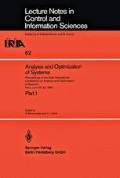Abstract
Two procedures designed for the detection of parameter jumps in autoregressive gaussian distributed processes — the generalized likelihood ratio (GLR) algorithm and the cumulated sum (CUSUM) algorithm — are compared regarding their performance. Both algorithms share as a common feature a growing reference window and a sliding fixed length test window, but use different detection statistics. Some rough features of the algorithms are deducted using means instead of the stochastic signal itself. More detailed results are then obtained from extensive simulations performed with different types of parameter jumps in the test signals. As a general result, it is shown that the CUSUM procedure may perform slightly better with respect to the detection of spurious jumps, if direction and distance of the jump is known in advance. On the other hand, the GLR algorithm leads to much better results in the detection and particularly the positioning of jumps succeeding each other in a short time interval (“short segments”). Moreover, the GLR algorithm is more robust considering the application of a segmentation procedure under realistic assumptions.
Preview
Unable to display preview. Download preview PDF.
References
A. v.Brandt, "On-line Segmentation of Time Series Using a Pilot Segment", Proc. Int. Conf. on Digital Signal Processing, Florence, 1981, pp. 1111–1118
U. Appel, A. v. Brandt, "Adaptive Sequential Segmentation of Piecewise Stationary Time Series", Information Sciences 29, 1983, pp. 27–56
G. Bodenstein and H.M. Praetorius, "Feature extraction from the electroencephalogram by adaptive segmentation", Proc. IEEE, vol.65, no. 5, May 1977, pp. 642–652
B.H. Jansen, A. Hasman and R. Lenten, "Piecewise analysis of EEGs using AR-modeling and clustering", Computers and biomed. Res. 14, 1981, pp. 168–178
D. Michael and J. Houchin, "Automatic EEG analysis: A segmentation procedure based on the autocorrelation function", Electroenceph. clin. Neurophysiol., vol. 46, 1979, pp. 232–235
J.S. Barlow, O.D. Creutzfeld, D. Michael, J. Houchin and H. Epelbaum, "Automatic adaptive segmentation of clinical EEGs", Electroenceph. clin. Neurophysiol., 1981, vol. 51, pp. 512–525
J. Rissanen, "Modelling by shortest data description", Automatica, vol. 14, 1978, pp. 465–471
A.C. Sanderson, J. Segen and E. Richey, "Hierarchical modeling of EEG signals", IEEE Trans. Pattern Analysis, Machine Int., vol. PAMI-2, no. 5, Sept. 1980, pp. 405–415
M. Basseville, A. Benveniste, "Sequential Detection of Abrupt Changes in Spectral Characteristics of Digital Signals", IEEE Trans. Inf. Theory, Sept. 1983; (see also: Research Report no. 129, INRIA, Centre de Rennes, April 1982)
U. Appel, A. v.Brandt, "A Comparative Study of Three Sequential Time Series Segmentation Algorithms", To appear in Signal Processing 1984
A.S. Willsky and H.L. Jones, "A Generalized Likelihood Ratio Approach to the Detection and Estimation of Jumps in Linear Systems", IEEE Trans. on Automatic Control, vol. AC-21, 1976, pp. 108–112.
Author information
Authors and Affiliations
Editor information
Rights and permissions
Copyright information
© 1984 Springer-Verlag
About this paper
Cite this paper
Appel, U., v. Brandt, A. (1984). Performance comparison of two segmentation algorithms using growing reference windows. In: Bensoussan, A., Lions, J.L. (eds) Analysis and Optimization of Systems. Lecture Notes in Control and Information Sciences, vol 62. Springer, Berlin, Heidelberg. https://doi.org/10.1007/BFb0004952
Download citation
DOI: https://doi.org/10.1007/BFb0004952
Published:
Publisher Name: Springer, Berlin, Heidelberg
Print ISBN: 978-3-540-13551-7
Online ISBN: 978-3-540-39007-7
eBook Packages: Springer Book Archive

